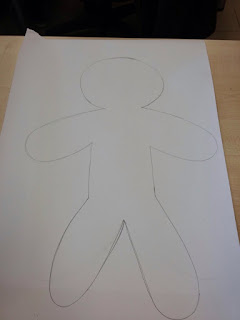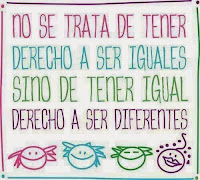martes, 31 de enero de 2017
PLAN SEMANAL DEL 1 AL 8 DE FEBRERO
Chicos, ya está aquí el próximo plan semanal
Esta semana tenemos :
Mate: Aprende los divisores con este super vídeo y practica en casa.
Socilengua: Investiga sobre la diversidad en tu familia.
Esta semana tenemos :
Mate: Aprende los divisores con este super vídeo y practica en casa.
Socilengua: Investiga sobre la diversidad en tu familia.
lunes, 30 de enero de 2017
DÍA DE LA PAZ
Hoy hemos pasado un estupendo Día de la Paz. Hemos escrito nuestros deseos y compartido la tarde con nuestros compañeros los Kolas y Soles verdes.
Además hemos comenzado a componer un Rap...ha sido genial :)
jueves, 26 de enero de 2017
VISITAMOS LA BIBLIOTECA GLORIA FUERTES
Hoy hemos ido a la Biblioteca Gloria Fuertes y hemos aprendido un montón de cosas sobre Madrid, lo hemos pasado genial:)
miércoles, 25 de enero de 2017
English Weekly Plan - Diversity
In this Weekly Plan we are going to learn a little bit more about diversity.
There are 3 activities to do (you have 2 weeks to complete them):
1st. A reading comprehension where you are going to learn about languages around the world.
2nd. You are going to write a postcard looking for information about a new country for you.
3rd. You are going to research about animals in different continents.
1. Read the language facts and answer the questions in your notebook. (Copy the questions and then answer).
AMAZING LANGUAGE FACTS
- There are more than 2,700 languages in the world. In addition, there are more than 7,000 dialects. A dialect is a regional variety of a language that has a different pronunciation, vocabulary, or meaning.
- One of the most difficult language to learn is Basque, which is spoken in northwestern Spain and southwestern France. It is not related to any other language in the world. It has an extremely complicated word structure and vocabulary.
- Somalia is the only African country in which the entire population speaks the same language, Somali.
- More than 1,000 different languages are spoken on the continent of Africa.
- The Berbers of North Africa have no written form of their language.
- Many languages in Africa include a click sound that is pronounced at the same time as other sounds. You must learn these languages in childhood to do it properly.
- There are 13 ways to spell the 'o' sound in French.
- The Bible is available in 2454 different languages. Pinnochio is a close second.
- South Africa has 11 official languages - the most for a single country.
- The language with the most words is English, boasting over 250,000 words.
- Learning a second language can make you smarter.
a) How many languages are there in the world? And dialects?
b) What is a dialect?
c) Which are the second and the third most spoken languages?
d) Why is Basque one of the most difficult languages to learn?
e) In which country does the entire population speak the same language? What language is it?
f) When do you need to learn African languages with click sounds to do them properly?
g) Why is it important to learn a second language?
h) How many languages are you learning at your school?
2. Write a postcard.
WHAT YOU NEED:
- A piece of cardboard, approximately the size of a postcard.
- Pencil.
- Markers, crayons, Manley wax crayons...
- A source of information (Internet, a book, a magazine...).
WHAT YOU HAVE TO DO:
- You will get a continent by raffle in class.
- Choose a country from that continent. (It has to be a country that you don't already know).
- Imagine that you have started a trip to that country and you are experiencing all the local culture it has to offer. Using your imagination (and looking for some information), write a postcard to your friend/teacher/parents... describing your experience.
- Look for this information about the country:
* Location
* Climate
* Language
* Religion
* Traditional dishes
* A famous place, monument, museum, etc.
* Something that you can do/visit there as a tourist.
- On the front side of the postcard, draw a picture that depicts something traditional in that country (find examples in Google Images).
- On the back side, write a message to your friend/teacher/parents... using the information you have.
Here you have an example:
Dear Trizza,
I am in Namibia. It is a country in southern Africa.
Its overall climate description is arid. There are more than 300 days of sunshine per year.
The official languages are English, German and Afrikaans, but they speak other languages (Khoekhoe language or Herero language).
Most of them are Christians but Namibia is home to a small Jewish community of about 100 members. One of the traditional dishes is Mopane worms. They fry them!!!
The world's oldest desert called Namib is located here. It is 80 million years old! The world's highest sand dunes are here, too, and at sunrise, we went to Sossusvlei to see them. They were so smooth and in the morning light, they appeared to be red! It was amazing.
Your friend,
Nieves.
3. Complete the drawing. Draw at least 2 animals per continent.
-
martes, 24 de enero de 2017
PLAN SEMANAL DEL 25 AL 1 DE FEBRERO
Hola compidiversos,
Esta semana tenemos una plan semanal muy entretenido y que nos va a hacer reflexionar un poquito.
SOCILENGUA: Pensamos cómo nos hacen sentir las imágenes y contestamos las preguntas.
MATE: Trabajamos con los múltiplos.
ADELANTE
Para ALBA, DANI E IRMA :
lunes, 23 de enero de 2017
Ecosystems - Video
I have created an assignment in Elesapiens with the video we watched in class before the introduction:
You can watch it again at home. Remember that you should use the English subtitles.
"ECOSYSTEMS - VIDEO".
You can watch it again at home. Remember that you should use the English subtitles.
Sewing in Arts!!!
Hello guys!
As you know, we are going to sew in Arts!!
It's going to be a new experience for most of us and
we are going to have a lot of fun!
We are going to make our own doll and we are going to learn a lot of new things related to our project: DIVERSITY.
Here are the steps to do this activity:
1. Choose different types of diversity that you want to show with your doll (gender, race, clothes, disability, religion, appearance...). Share these ideas with your group and make decisions together.
2. Draw your doll's body in a piece of cloth using the patterns the teacher has. We will give you these pieces of cloth depending on the color you have chosen. The teacher will explain how to do it in class - PAY ATTENTION because this part is very important.
3. Cut the doll's body. The whole group has to work together as it is a little bit difficult.
4. Do a running stitch to prepare to sew the dolls: "hilvanar"
5. Sew your doll's body, but leave a little unstitched space so you can put the foam inside.
6. Turn the doll's body over and fill it with foam. Now, finish sewing it.
Now the doll's body is done.
To be continued...
martes, 17 de enero de 2017
ICT zone
1. Watch the video below "Day in the life of a Stormtrooper"
2. Complete your Present Simple worksheet.
When you finish, you can do your Elesapiens assignments.
There are 3 games to play: ICT 1, ICT 2, ICT 3.
PLAN SEMANAL DEL 18 AL 25 DE ENERO
Hola diversicompis
Esta semana tenemos un plan semanal muy entretenido:
Lengua: Inventamos definiciones diversas con la guía.
Mate: Vemos el vídeo casero que han preparado las profes para descubrir lo que vamos a empezar a trabajar en clase la próxima semana y completamos la hoja que nos han dado impresa.
Para Irma, Dani y Alba:
Esta semana tenemos un plan semanal muy entretenido:
Lengua: Inventamos definiciones diversas con la guía.
Mate: Vemos el vídeo casero que han preparado las profes para descubrir lo que vamos a empezar a trabajar en clase la próxima semana y completamos la hoja que nos han dado impresa.
A POR ELLO :)
Para Irma, Dani y Alba:
lunes, 16 de enero de 2017
TUTORIAS DE IGUALES
Ya hemos comenzado a disfrutar de las tutorías de iguales con nuestros compañeros de infantil, nos ha encantado :)
Suscribirse a:
Comentarios (Atom)






















































